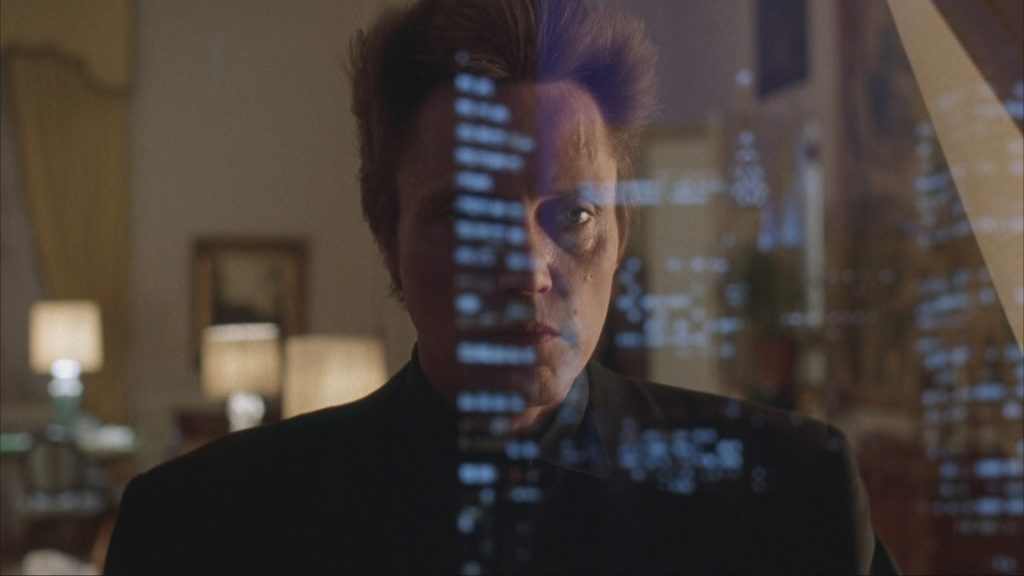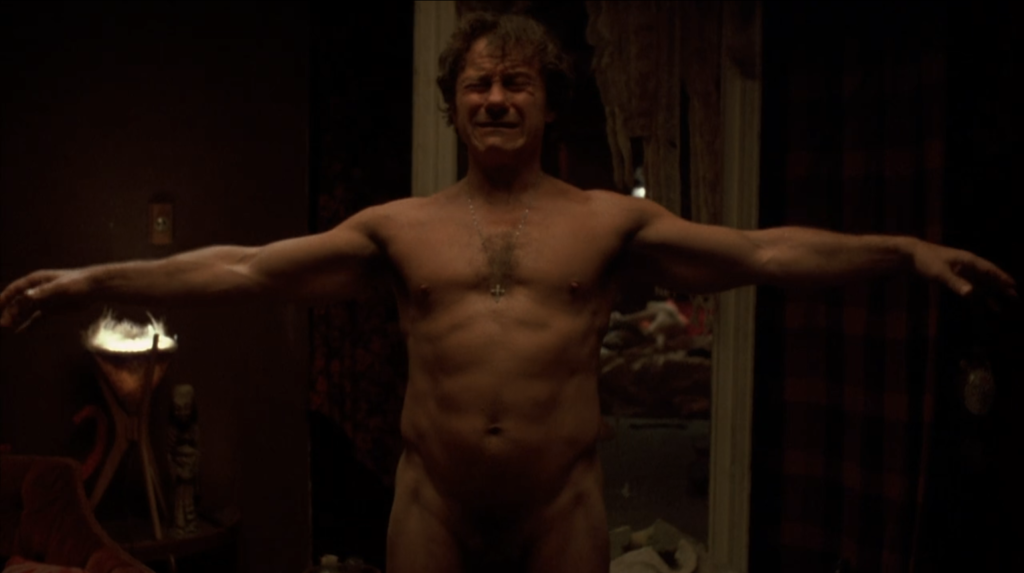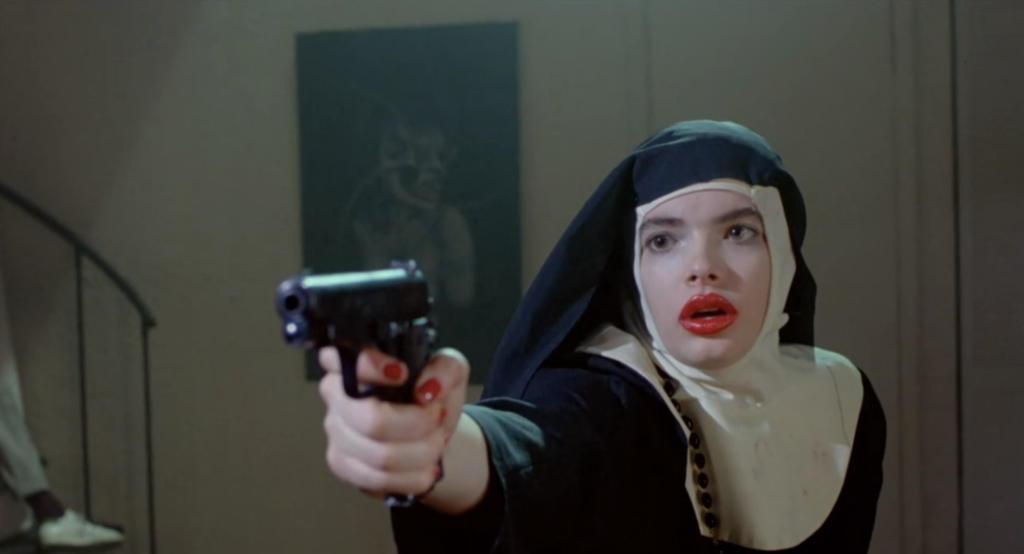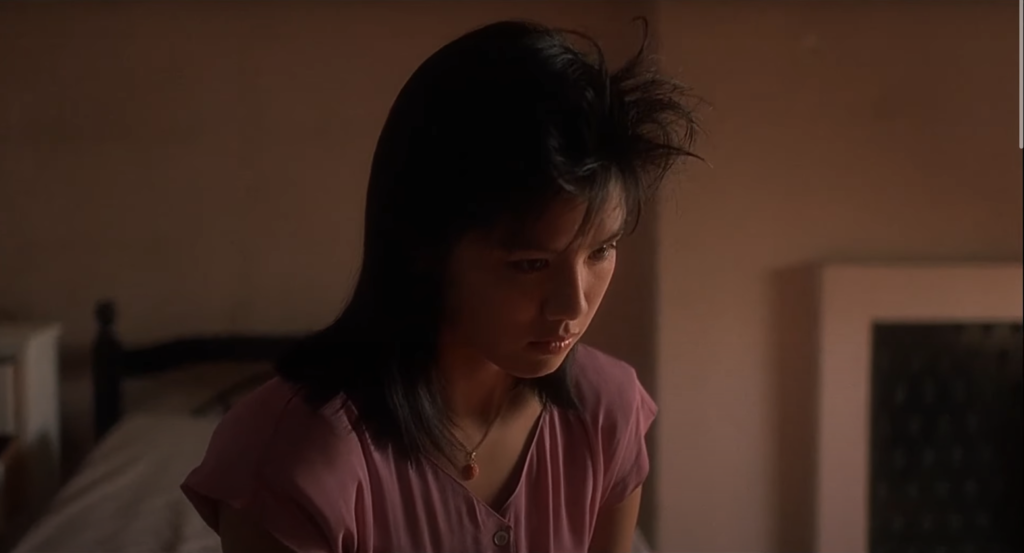| Michael Wellvang |

King of New York plays at the Trylon Cinema from Sunday, November 26th through Tuesday, November 28th. Visit trylon.org for tickets and more information.
Editor’s note: this essay contains a passing mention of sexual assault.
Abel Ferrara’s King of New York is not a “great movie.” Nor is it trying to be. The timing of its release, just nine days after Martin Scorsese’s Goodfellas, has invited unfair but inevitable comparisons that plagued the film since before it was ever shown. So let’s get one thing straight: if you’re expecting Scorsese, you will be disappointed. Horrified, even. But if you let Ferrera do his thing, and have a sense of who he is, King of New York will be a wild ride.
So what is his thing?
Ferrara makes exploitation films. Or at least, he did for much of his career.
For the uninitiated, an exploitation film exploits the public’s sensibilities in order to garner attention. It’s therefore not a genre so much as a marketing technique. Nonetheless, films described as exploitative generally include subject matter that rides the line between what is considered acceptable and obscene. Predictably, there’s a lot of sex, drugs, violence, and gore.
Exploitation as a practice is as old as filmmaking itself, but as a term, it is most closely associated with low-budget action, horror, and pornographic films made outside of the traditional Hollywood studio system from the 1950s-80s. It was during this time that Ferrara came of age.
Who is Abel Ferrara?
Born and raised in the Bronx, Ferrara directed his first feature at the age of twenty with a 1971 pornographic film entitled 9 Lives of a Wet Pussy. He cast his girlfriend as well as himself (to perform in separate scenes, mind you). Ferrara collaborated with Nicholas St. John, who would subsequently write all of his features up through King of New York save for one. Ferrera acted again in his narrative debut, Driller Killer, which follows a starving artist who turns from painting to, well, drilling. With Rochelle Films as its distributor, Driller Killer found a certain amount of play in the UK’s underground horror scene. But his true breakout was Ms .45 in 1981.
Ms .45 follows a mute, high-fashion seamstress in Manhattan who has the misfortune of being raped twice on her way home from work one day. She then embarks on a rampage targeting any man who catcalls her. The film is a feast for the eyes and features a stellar performance from Zoë Tamerlis in the lead role, despite her only saying one word in the entire film.
Thanks in part to a rave review by LA Times film critic Kevin Thomas, Ms .45 cemented Ferrara’s reputation as a master of the exploitation film. There was a sense, however, that audiences saw the film as a potential stepping stone to more nuanced cultural commentary, if for no other reason than it simply looked so good when compared to other B-movies. Visually, Ms .45 shares more in common with highly artistic French and German New Wave works than, say, Blood Sucking Freaks (also distributed by Rochelle Films). But given the lurid subject matter, Ms .45 tended to be lumped in with the latter in the United States.
Quentin Tarantino observed of Ferrara in a recent interview, “I thought [back then] this guy is amazing…he could be…a new Scorsese.” It’s a sentiment that would follow Ferrara to King of New York, about what his work might be if he took a more writerly approach. Roger Ebert remarked in his Chicago Sun Times review, “What Ferrara needs for his next film is a sound screenplay…His effects are too good, his command of mood is too sure, for him to continue trying to bluff his way through half-written movies like this one.”
These sentiments, while understandable, dismiss what Ferrera is doing in his collaborations with St. John. He bridges arthouse with dirty B-movies, and neither of those are particularly concerned with plot. Ferrara understands there’s stylistic freedom in movies where the director isn’t trying to show how clever he is. He can do things like give his protagonist a nun’s habit and a gun in the climax of a film, without answering, “What does it all mean?” To ask Ferrara to move beyond that kind of filmmaking is to ask him to give up what made him great in the first place. King of New York would not hold up if Ferrara were to conform to a different style of filmmaking, because the movie is all in service of one thing: spectacle.
Are you not entertained?
A good spectacle has a healthy dose of eccentricity. If there’s anything to take away from Ferrara’s style, it’s that he doesn’t lay it on lightly. This can be seen from the beginning of King of New York, when a man is shot about a million times from all sides in a phone booth by sunglassed executioners. The sunglasses stay on for the rest of the movie, even in death.
The eccentricity of the film runs much deeper than any costume choice, however. Let’s look at the obvious: Christopher Walken’s portrayal of Frank White, the criminal kingpin who wants to run for mayor. Or save a hospital. It’s hard to tell where his ambitions lie, or how he’ll go about them, but it doesn’t matter, because Frank is so far from looking or acting like your typical movie mob boss that all expectations for who or what this character is go right out the window.
At the heart of Frank’s eccentricity is his hair. At the beginning of the film, it’s slicked back as he is escorted out of prison. He arrives home, and the first thing he does is spike his hair in the shower as a cathartic reassertion of his individualism. It remains as such for the duration of the film. Now, we all know the Christopher Walken of today, the Thinking Man’s Nicholas Cage, who flies around in music videos. But in 1990, he was still riding the last bit of wave from his Oscar-winning role in Michael Cimino’s The Deer Hunter. He was a serious leading man. It wasn’t yet in his contract to look like a saxophone teacher at all times. But under Ferrara’s direction, Frank White needs to appear dramatic. Most, if not all, of his protagonists have a certain attention-grabbing look to them.

Harvey Keitel as the Lieutenant in Bad Lieutenant

Zoë Temurlis as Thana in Ms .45

Sari Chang as Tye in China Girl
One purpose of having dramatic protagonists is to make them, in a sense, larger than the film itself. In choosing to see an exploitation film, you’re probably not going for the social commentary—you’re going for that guy. Directors know this, and often title the film describing the hero: Mad Max, Bad Lieutenant, The Toxic Avenger, King of New York.
As indicated above, a striking appearance acts as a sort of palate cleanser for a character, lessening comparison to an archetype, which in this case is a mobster. The audience is therefore more likely to accept deviation from that archetype. We see this rule in action following Frank’s shower catharsis when he steps out into his Plaza Hotel suite to meet his associates in full, spiky-haired form for the first time. There’s a predictably tense exchange when Frank’s lieutenant Jimmy Jump (Laurence Fishburn) arrives to see his old boss, but it’s immediately released when Frank breaks into a short but vigorous dance number. When was the last time you saw a mob boss dance? With the hair, it just works.
Speaking of eccentric movement, we see a lot of that from Frank, too. Perhaps more than we are comfortable with. I’m specifically talking about his tongue, all over his lawyer’s (girlfriend’s?) face, during a public makeout session on the subway. Ferrara has no problem grossing out his audience or potentially severing their sympathy for the protagonist in pursuit of showing how indulgent of a man Frank is, because it’s all in service of playing with the audience’s expectations of what we’re about to see. A great spectacle has ups and downs, gives and takes. So, while we are repulsed in the makeout, we are immediately won back by Frank deftly handling a group of would-be muggers by offering them a job. “Ask for me at the Plaza,” Frank says. Brilliant.
Character development? No thanks.
Ferrara forgoes saying much of anything about most of his characters in the film. For example, Sergeant Bishop (Victor Argo), despite being the primary antagonist, is basically just shown drinking and smoking while looking at police documents when he’s alone on screen. There’s cursory information, of course, such as that he’s devoted to his men, and upholding the law, but he’s nothing more than a prop for Frank to rail against. A writerly view of King of New York looks down on this level of one-dimensionality; however, the film would not gain much by humanizing him more. If Bishop, or really any of these supporting characters, were to have more agency, the illusion of this pulp world that Ferrara has created would fall apart.
Frank struts around town with two female bodyguards who also kiss him, and appear naked in his bed. Who are these people? Are they comfortable with this shared arrangement of Frank’s affections? Which one would fold more easily under questioning? With so much action packed into this film, there isn’t a lot of room to explore. But Frank’s mystique benefits from having a polyamorous praetorian guard, and that’s all that matters for the vibe of the film.
This is not to say Ferrara is inept at communicating about his characters. Laurence (credited as Larry) Fishburn, who is second only to Walken in screen time, has almost nothing explicitly revealed about his character, Jimmy Jump. But it doesn’t feel that way. Consider the following interaction: midway through the film, Detective Gilley (David Caruso) confronts Frank’s crew, and spits on Jimmy’s face. In an intimidating move, Jimmy pauses and proceeds to rub the spit all over his lips. He then sticks his spit-covered fingers into his mouth and sucks them clean. Without a word of dialogue, we can ascertain just how hardboiled Jimmy is, how little he’s concerned with police pressure, and the level of enjoyment he takes from his position as a gangster. This scene is a masterclass in nonverbal communication. It’s also completely unrealistic. In the hands of a more sophisticated director, this scene would have been a disaster, veering off into parody territory. But that’s the genius of Ferrara. He has complete confidence in his fantastical, hardboiled world.
Last words
Like any exploitation movie, King of New York is not for everyone. Even Ferrara’s own wife walked out of its premiere, so there is no shame in not digging the vibe. Ferrara built a career on shunning good taste and showcasing some of the most reprehensible subject matter in the most stylized manner possible. If he’d had complete control, it is likely none of his films would have anything less than an NC-17 rating. In an era of endless sequels and reboots, I find comfort in the fact that not too long ago, an old-school exploitation flick, wearing the disguise of a studio film, pulled its mask off and reared its spiky-haired head onto suburban multiplex screens everywhere.
Edited by Olga Tchepikova-Treon
